Agora 2025-3 Teaching First Peoples Histories
Non-members can purchase print and digital issues from the HTAV Shop.
Teaching First Peoples Histories | Agora vol. 60 no. 3 (2025)
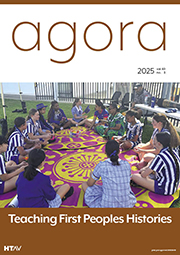 |
|
| REFLECTION/EDITORIAL |
|
THEMA Reflections on the theme |
|
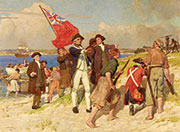 |
Indigenous Accounts of Cook’s Discovery of Australia Darren Rix and Craig Cormick Indigenous knowledge holders across Australia provide accounts of Cook’s encounters that contrast with the journals of those who sailed on board the Endeavour.
|
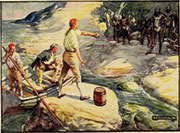 |
Encountering Indigenous Histories: Contact, Engagement, and Two Ways of Looking Leonie Stevens and Lynette Russell Often we only have one side of the story, but additional sources of evidence allow us to infer the perspectives of Australia’s First Nations peoples when they encountered early explorers like Matthew Flinders and William Dampier. |
 |
‘What If I Get It Wrong?’: Teaching First Nations Perspectives as Non-Indigenous History Educators Sara Weuffen Some evidence-based recommendations can help overcome ‘epistemic inertia’ when it comes to learning about, interrogating and integrating First Nations content. |
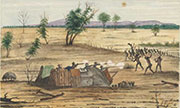 |
Teaching Frontier Conflict: Perspectives of a Non-Indigenous Educator Bill Lewis Frontier conflict is a significant part of Australian history, with profound impacts on Aboriginal and Torres Strait Islander peoples. How should you teach such a sensitive topic? |
 |
The Storm over Indigenous Placenames on Wikipedia Francesca Sidoti and Heather Ford The dominant conservative ideology held by Wikipedia’s editors tends to delegitimise Australia’s First Nations history through a very particular application of Wikipedia’s rules. |
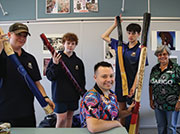 |
Four Questions We Tried to Answer When Creating our Deep Time Unit Sarah Muller and Uncle Michael-Andrew Kyron Wilesmith A Ngarigo Elder and a History teacher discuss the collaboration that took place when they developed an engaging and authentic unit on Australia’s deep time history. |
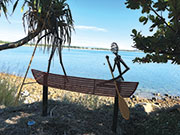 |
Teaching Deep Time Australia: The Importance of Place Kath Burke and Peter Leete The study of deep time history in Year 7 is an opportunity to make learning more meaningful through place-based learning. |
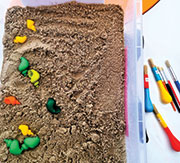 |
Navigating Deep Time: A Dual Perspective on Teaching Australia’s Ancient Past Leigh Jackson and Kelly Allgood Two teachers discuss the approaches they have adopted when developing a Deep Time unit. |
 |
A Collaborative Yarn on Australian Indigenous History Scott Alterator, Georgia L. Stannard and Katherine Ellinghaus While history is complex, understanding our positionality and its relationship to the discipline is even more so. This yarn looks at three different personal and disciplinary perspectives on Australian Indigenous history. |
 |
How to Decentre ‘Whiteness’ in Historical Education Mina Murray and Julie Bover A Wiradyuri historian and a non-Indigenous teacher bring different lived experiences and professional perspectives to urgent questions about truth-telling and Western ways of teaching History. |
 |
How the University of Melbourne Marginalised Indigenous Australia James Waghorne, Ross L. Jones and Marcia Langton While prominent academics at the University of Melbourne were proponents of the worst excesses of race science, steps have been taken to support Indigenous students and communities. |
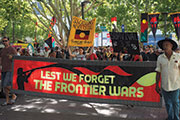 |
Demythologising the Frontier Wars Alison Bedford and Vince Wall Eight principles for teaching Australia’s Frontier Wars are re-evaluated in the aftermath of the Voice referendum and the emergence of artificial intelligence. |
 |
Building Ethical and Practical Capacity in Teaching First Peoples History Megan Thompson What reduces variability in the quality of History teaching is not a list of links to online resources but a protocol that binds ethics, practice and First Nations guidance. |
PRAKTIKOS Teaching ideas |
|
 |
Moving Beyond Deficit Discourse when Teaching First Nations History Lyndon Pratt Ditch deficit narratives with ready-to-use strategies that centre First Nations voices, spotlight resilience, and teach Australian history with accuracy, respect and rigour. |
 |
The Great Australian Silencing of the Lambs Aleryk Fricker A simple advertisement for lamb perpetuates colonial mythologies, but critical engagement can help students to engage with historical truth-telling. |
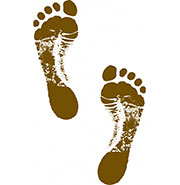 |
Teaching the Lake Mungo Footprints Kara Taylor Lake Mungo’s ancient footprints offer a relatable way for students to appreciate continuing Aboriginal culture from deep time to today. |
 |
Teaching Historical Knowledge of our Ancient Past with Indigenous Artefacts Nerissa Marcon By analysing Indigenous artefacts, students learn to think like historians by making educated guesses about what they may have been used for. |
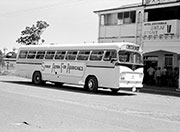 |
Evaluating Indigenous Civil Rights in Historical and Modern Contexts Justine Bell A unit comparing Australia’s Indigenous civil rights movement with the United States also allows students to consider changes in modern Australian society as a whole. |
| KRITIKOS Reviews |
All reviews are available online
|
Events Calendar
- 27 Feb 26
- 19 Mar 26
- 31 Mar 26





 /htav_ed
/htav_ed